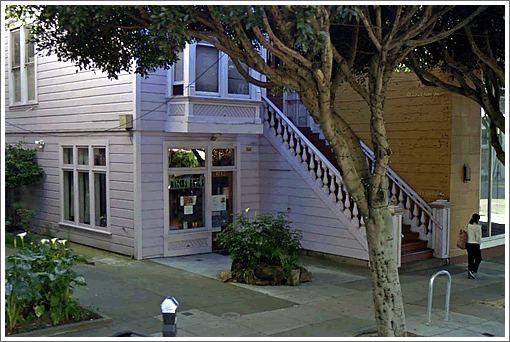
Moved from Post to Fillmore Street as part of the San Francisco Redevelopment Agency’s plan to redevelop the Western Addition, 1712-1716 Fillmore Street is set to become San Francisco’s 266th Historic Landmark.
Unanimously approved by San Francisco’s Board of Supervisors yesterday, the building which once housed Jimbo’s Bop City – the place to play as a Jazz artist from 1950 to 1965, with the likes of Duke Ellington, Miles Davis, Dizzy Gillespie, Billie Holiday, Count Basie, Dinah Washington, and John Coltrane having graced the stage which was open until 6am – is a ceremonial second Board vote and the Mayor’s signature away from landmark status.
Marcus Books, the nation’s oldest continuously operating and independent Black-owned and Black-themed bookstore, moved into the ground floor of the building in 1980.
The mayor should veto it, and propose 10 story condos with a Google bus stop in front, just because I need some excitement this morning.
So there’s two disjoint criteria for designating a building as historic (aside from being old of course). The most obvious is that the building exhibits extraordinary or unique architecture. The other is that interesting things happened in an otherwise nondescript building, as in this case.
The latter case is tricky because you’d need to do some research to figure out whether something noteworthy occurred in the building. I once stalled bidding for a property that had a nondescript run-down shack sitting in a large well sited parcel. The only reasonable approach was to tear down the little 700 sq.ft. shack and build a new house. But what if some famous author wrote her opus in that shack back in the 1930s?
I’m only moderately good at doing historical research. Are there professionals who specialize in this? Kind of like hiring a geologist to figure out whether the parcel sits atop a slide zone.
Pretty soon all buildings will be historic landmarks to prevent tear downs and additions. AKA if you own it, you are stuck with it forever.
Milkshake, oh yes, there is a whole priesthood of architectural historians who subsist on doing that very thing. The Historical staff at the Planning Department have a list of “approved” consultants, from which they select the proper one (and whom you get to pay) when they demand an Historical Research Analysis Report (which they do for many buildings over 50 years old – i.e., virtually every building in SF).
This is all very well and good. However, the effort is motivated to save the book store business. In this day and age of Amazon and the demise of the ethnic book store, it is problematic how long Marcus’ will survive. Then there will be a landmark building without Marcus’.
I thought the story was:
1. The owners of this bookstore borrowed too much money when credit was easy. Euphemistically we call this ‘A bad financial decision’ Like the ones you make in Vegas.
2. Surprise! They couldn’t pay it all back. The lender foreclosed.
3. The trustee auction buyer wants to take possession of the house (like, since they own it and stuff).
4. The community (not asking of course, what happened to the money the store owners originally borrowed and couldn’t pay back). They’re like, ‘Let’s landmark this b*tch’ That always makes stuff difficult. Or drives down the value.
5. SF Political establishment is like, ‘Yeah, down with the man! Not us of course, we mean like, “the man” We feel bad about redevelopment issues from 50 years ago. Let’s light this Preservation thing off and see where it lands.
by sheer coincidence, just today I happened to read, in Gary Kamiya’s Cool Gray City of Love, chapter 41: The Haunted House, which is dedicated to the story of this building (which goes back much further even than Bop City). whatever the current motivation, I hope the effort to preserve it succeeds, and it sounds like the non-profit’s offer (see true-dat’s link) to the current owners is a good way to accomplish that.
about 3/4 down in my link is a brief mention of the book’s reference to this structure
UPDATE: Nations Oldest Black Bookstore Locked Out Of Landmarked Building.